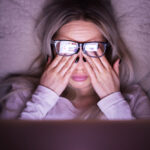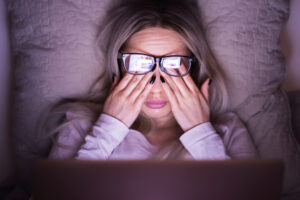Dry eye houston,Eye health,Ophthalmology houston

One thing that definitely can’t be argued about the last year is that the majority of us have been subjected to screens and the ‘digital world’ way more than before.
All of our in-person meetings became virtual, and many of us can’t help but feel some eye strain at the end of the day.
That translates to different things for different people, but digital eye strain (sometimes referred to as computer vision syndrome) can cause:
- Blurriness
- Headache
- Eye pain
- Dry eyes, or even
- Light sensitivity
Since so many of us started to suffer more from one or more of the above symptoms since the pandemic hit, it is not a shock that Blue-light blocking glasses have become WAY more popular than they ever were.
We wanted to find out more about whether these glasses, which are relatively affordable for everyone, are effective and if they actually help people with digital eye strain.
Some companies not only claim that these glasses help with the eye strain we feel all day, but that they can actually improve our sleep patterns or help us avoid eye disease!
We asked our doctors at Slade & Baker Vision about these claims because we found out that the American Academy of Ophthalmology does not stand behind or recommend the use of blue-light-blocking glasses due to the fact that there is no scientific evidence that they complete any of the above.
Our doctors shared that the blue light that our computers emit is NOT what causes eye strain since apparently eye strain is caused by being close up to the screen for long amounts of time.
They also shared that there really is no evidence that blue light from our computers will give us eye disease or more risk to develop eye disease.

Regarding the ‘better sleep’ claim, we love this topic, as we have covered the effect that blue light has on SLEEP in this recent blog; so we know there is a sleep benefit gained from limiting blue light.
The question is how much blue light is actually emitted from our screens and whether our circadian rhythms are affected. As we shared in our previous blog, our phones now have light mode change abilities and ‘night time’ mode, so we can really limit the blue light being emitted as opposed to having to buy these glasses.
Our doctors shared that the sun and UV light is actually way more dangerous and emits a ton more blue light than our screens do. Not to mention that UV light causes more chances of cataract development or even eye cancer.
All in all, since these glasses are really inexpensive, our doctors don’t necessarily tell our patients not to invest in them. They share that if patients feel these glasses have helped them, it’s a good method to try, but that everyone should steer clear of believing any medical claims made by the manufacturers of these glasses.
Our doctors also encourage patients to minimize digital eye strain by following the 20/20/20 rule encouraged by the organization Prevent Blindness. The rule is: While you are in front of a screen, look away at an object that is 20 feet away from you for 20 seconds, and do this at least every 20 minutes. This gives your eyes a proper ‘relax’ break!
If you feel you are suffering blurry vision or any of the symptoms above and would like to discuss your vision with our specialists, please call us today to schedule an appointment at 713-626-5544 or write us at info@visiontexas.com to find out about availability.
We always encourage an exam to rule out anything other than digital eye strain that may be causing these symptoms!





